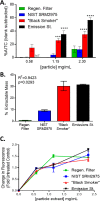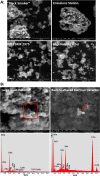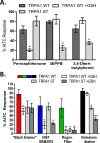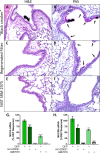Differential Activation of TRPA1 by Diesel Exhaust Particles: Relationships between Chemical Composition, Potency, and Lung Toxicity
- PMID: 30945539
- PMCID: PMC6959364
- DOI: 10.1021/acs.chemrestox.8b00375
Differential Activation of TRPA1 by Diesel Exhaust Particles: Relationships between Chemical Composition, Potency, and Lung Toxicity
Abstract
Diesel exhaust particulate (DEP) causes pulmonary irritation and inflammation, which can exacerbate asthma and other diseases. These effects may arise from the activation of transient receptor potential ankyrin-1 (TRPA1). This study shows that a representative DEP can activate TRPA1-expressing pulmonary C-fibers in the mouse lung. Furthermore, DEP collected from idling vehicles at an emissions inspection station, the tailpipe of an on-road "black smoker" diesel truck, waste DEP from a diesel exhaust filter regeneration machine, and NIST SRM 2975 can activate human TRPA1 in lung epithelial cells to elicit different biological responses. The potency of the DEP, particle extracts, and selected chemical components was compared in TRPA1 over-expressing HEK-293 and human lung cells using calcium flux and other toxicologically relevant end-point assays. Emission station DEP was the most potent and filter DEP the least. Potency was related to the percentage of ethanol extractable TRPA1 agonists and was equivalent when equal amounts of extract mass was used for treatment. The DEP samples were further compared using scanning electron microscopy, energy-dispersive X-ray spectroscopy, gas chromatography-mass spectrometry, and principal component analysis as well as targeted analysis of known TRPA1 agonists. Activation of TRPA1 was attributable to both particle-associated electrophiles and non-electrophilic agonists, which affected the induction of interleukin-8 mRNA via TRPA1 in A549 and IMR-90 lung cells as well as TRPA1-mediated mucin gene induction in human lung cells and mucous cell metaplasia in mice. This work illustrates that not all DEP samples are equivalent, and studies aimed at assessing mechanisms of DEP toxicity should account for multiple variables, including the expression of receptor targets such as TRPA1 and particle chemistry.
Conflict of interest statement
The authors declare no competing financial interest.
Figures








References
-
- Hammond D. M.; Dvonch J. T.; Keeler G. J.; Parker E. A.; Kamal A. S.; Barres J. A.; Yip F. Y.; Brakefield-Caldwell W. (2008) Sources of ambient fine particulate matter at two community sites in Detroit, Michigan. Atmos. Environ. 42, 720–732. 10.1016/j.atmosenv.2007.09.065. - DOI
-
- Mauderly J. L. (2010) Current Status of the Toxicology of Diesel Engine Exhaust - and the ACES Project. Zentralbl. Arbeitsmed., Arbeitsschutz Ergon. 60, 412–417. 10.1007/BF03346132. - DOI
-
- Hazari M. S.; Haykal-Coates N.; Winsett D. W.; Krantz Q. T.; King C.; Costa D. L.; Farraj A. K. (2011) TRPA1 and Sympathetic Activation Contribute to Increased Risk of Triggered Cardiac Arrhythmias in Hypertensive Rats Exposed to Diesel Exhaust. Environ. Health Perspect. 119, 951.10.1289/ehp.1003200. - DOI - PMC - PubMed
Publication types
MeSH terms
Substances
Grants and funding
LinkOut - more resources
Full Text Sources
Miscellaneous

